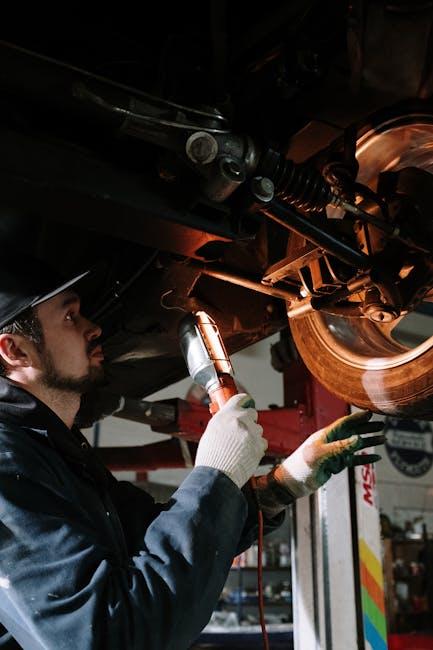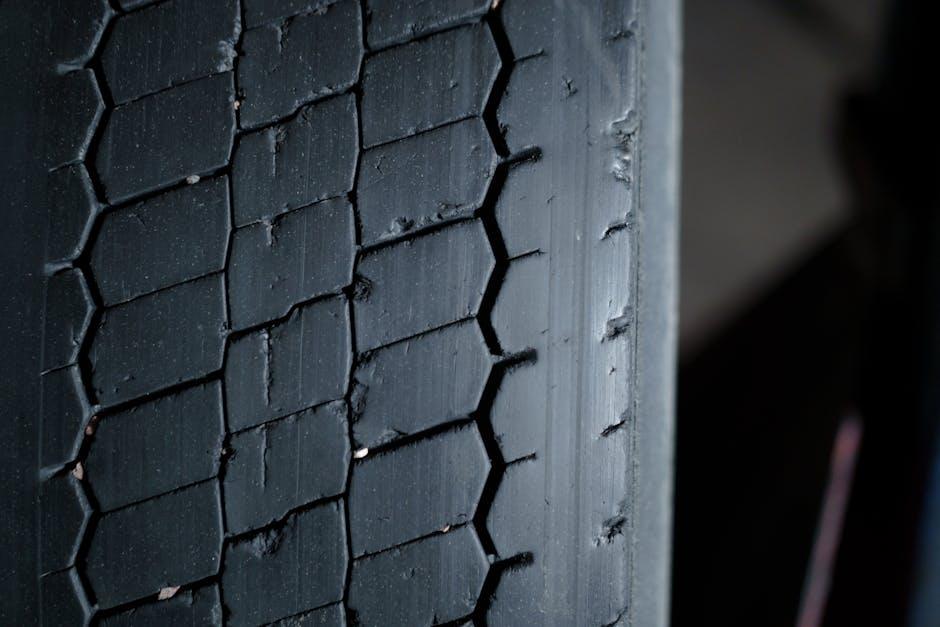Your car’s suspension is the unsung hero of every smooth drive, quietly absorbing bumps and keeping you firmly planted on the road. Yet, unlike the engine or brakes, it often goes unnoticed until something feels off. Knowing how to test your car’s suspension can save you from unexpected discomfort, costly repairs, or even safety hazards. In this article, we’ll guide you through simple, effective ways to assess the health of your suspension system, helping you drive with confidence and comfort.
Table of Contents
- Understanding the Role of Your Car’s Suspension System
- Spotting Early Signs of Suspension Wear and Tear
- Performing a Visual Inspection for Damage and Leaks
- Conducting a Bounce Test to Gauge Shock Absorber Performance
- Evaluating Tire Wear Patterns for Suspension Issues
- When to Seek Professional Suspension Diagnostics and Repairs
- Q&A
- The Conclusion

Understanding the Role of Your Car’s Suspension System
At the heart of every smooth drive lies the vital function of your vehicle’s suspension system. It’s not just about comfort; the suspension ensures your tires maintain consistent contact with the road, providing stability and control during acceleration, braking, and cornering. Ignoring its health can lead to uneven tire wear, poor handling, and even safety hazards. Recognizing early signs of wear or malfunction can save you from costly repairs and keep your car performing at its peak.
To evaluate your suspension without professional tools, start with a simple bounce test:
- Press down firmly on the front or rear of your car and then quickly release.
- Observe how the car responds—ideally, it should rebound smoothly and settle without excessive bouncing.
Additionally, listen for unusual noises, check for visible damage or leaks around shocks and struts, and monitor how your vehicle handles on turns or uneven surfaces. Here’s a quick reference table to identify common suspension symptoms and probable causes:
| Symptom | Possible Cause |
|---|---|
| Excessive bouncing after a bump | Worn shock absorbers or struts |
| Uneven tire wear | Misaligned suspension components |
| Pulling to one side when driving | Damaged springs or alignment issues |
| Clunking or knocking sounds | Loose or broken suspension parts |

Spotting Early Signs of Suspension Wear and Tear
One of the earliest indications that your car’s suspension system might be wearing down is an unusual level of bounce or sway after passing over bumps or rough terrain. If the vehicle continues to bob excessively after a quick press on the front or rear, it means the shock absorbers or struts could be losing their effectiveness. Another subtle but critical symptom is unusual tire wear patterns. Uneven tread wear often points to misaligned or worn suspension components, which can compromise your ride comfort and safety.
Pay attention also to strange noises like clunks, rattles, or squeaks when driving over bumps or during turns. These sounds frequently signal loose or damaged suspension parts such as bushings, ball joints, or control arms. Here’s a quick checklist to help you monitor the early signs of degradation:
- Excessive vibration at the steering wheel
- Pulling to one side while driving
- Visible fluid leaks on or near shocks/struts
- Noticeable dips or drops when applying brakes

Performing a Visual Inspection for Damage and Leaks
Start by carefully examining the suspension components for any visible signs of wear or deterioration. Look for cracks, rust, or corrosion on the springs, control arms, and shock absorbers. Damaged coil springs or bent control arms can drastically affect your car’s handling and safety, so spotting these issues early is crucial. Don’t forget to check the rubber bushings and mounts—they should be intact and free from tears or excessive hardness, as these parts cushion and absorb vibrations during driving.
Next, monitor the area beneath your vehicle for any fluid leaks, a common indicator of shock or strut failure. Use a flashlight to scan around the dampers and adjacent regions; oily residue can signify compromised seals. Here’s a simple reference table to help identify fresh versus old leaks:
| Leak Type | Appearance | Likely Cause |
|---|---|---|
| Fresh Leak | Wet, shiny, and dark fluid | Active shock absorber seal failure |
| Old Leak | Dry, crusty residue | Previous leak, possibly repaired or dormant |
| Rusty Stains | Orange-brown discoloration | Metal corrosion due to moisture exposure |
- Tip: Focus on the areas right above the tires and underneath the wheel wells.
- Safety First: Always ensure the car is securely lifted before performing these checks.

Conducting a Bounce Test to Gauge Shock Absorber Performance
To check how well your shock absorbers are functioning, the bounce test is an easy and reliable method you can perform right in your driveway. Begin by pressing down firmly on one corner of your car, typically above the wheel, and then quickly release it. Observe how your vehicle responds to this impulse. Ideally, your car should bounce up once and settle back smoothly without any excessive movement.
Signs to look out for during your bounce test include:
- Multiple bounces or a prolonged rocking motion, indicating worn shocks.
- An immediate return to the original position without any bounce, which may suggest overly stiff shocks.
- Uneven bounce responses on different corners, hinting at inconsistent shock absorber wear.
| Bounce Test Result | Likely Shock Absorber Condition |
|---|---|
| One smooth bounce | Good condition |
| More than one bounce | Shock absorbers need replacement |
| No bounce, stiff response | Check for overly stiff or damaged shocks |

Evaluating Tire Wear Patterns for Suspension Issues
One of the key indicators of suspension problems lies in how your tires wear over time. Look closely at each tire’s surface: uneven tread wear can signal a misalignment, broken suspension components, or improper balance. For example, feathering (a sawtooth pattern on the tread) often points to alignment issues, while cupping (random high and low points) suggests worn shocks or struts. These wear signs don’t just affect ride comfort—they can compromise safety and handling, so spotting them early is crucial.
To systematically evaluate tire wear, check for the following patterns:
- Inside Tread Wear: May indicate camber problems or worn components causing the tire to tilt inward.
- Outside Tread Wear: Often a result of steering or alignment issues pushing the tire outward.
- Center Tread Wear: Could mean over-inflated tires, putting excessive pressure in the middle.
- Edge Tread Wear: Usually linked to under-inflated tires or suspension sagging.
| Wear Pattern | Possible Suspension Cause | Suggested Action |
|---|---|---|
| Feathering | Misaligned suspension | Get a professional wheel alignment check |
| Cupping | Worn shocks or struts | Inspect and replace suspension dampers |
| Inside Wear | Camber angle issues | Check suspension arms and adjust camber |
| Outside Wear | Toe-out alignment fault | Realign toe settings |

When to Seek Professional Suspension Diagnostics and Repairs
If you notice persistent issues such as uneven tire wear, excessive bouncing, or unusual noises even after performing basic suspension checks, it’s crucial to bring your vehicle to a professional. These symptoms often indicate deeper problems like worn-out shock absorbers, broken springs, or misaligned components that require specialized diagnostic tools and expertise. Ignoring these signs not only compromises ride comfort but also endangers your safety by affecting vehicle handling and braking efficiency.
A professional suspension inspection usually involves:
- Comprehensive road tests to identify subtle handling issues.
- Visual and mechanical inspection using lift equipment.
- Advanced diagnostic devices to measure suspension geometry and damping performance.
| Symptom | Potential Issue | Recommended Action |
|---|---|---|
| Clunking Noise | Worn Ball Joints | Professional Inspection & Replacement |
| Vehicle Pulls to One Side | Suspension Misalignment | Wheel Alignment Service |
| Excessive Bounce | Faulty Shock Absorbers | Shock Replacement |
Q&A
Q&A: How to Test Your Car’s Suspension
Q: Why is testing my car’s suspension important?
A: Your car’s suspension is the unsung hero that keeps your ride smooth, stable, and safe. Testing it regularly helps detect worn-out components before they cause poor handling, uneven tire wear, or uncomfortable rides.
Q: What are some simple signs that my suspension might be failing?
A: Look out for excessive bouncing after hitting a bump, a nose-dive when braking, uneven tire wear, or a drifting sensation when turning. If your car feels more like a boat on waves than a solid machine, your suspension might be waving a red flag.
Q: How can I perform a basic bounce test on my suspension?
A: Find a flat surface, push down firmly on the front or rear corner of your car, then release. The car should bounce up once or twice before settling. More than two bounces usually indicate worn shock absorbers or struts.
Q: Can I test the suspension by visually inspecting it?
A: Absolutely! Check for signs of oil leaks around shocks or struts, cracked or broken bushings, and any sagging springs. Look at tire treads for uneven wear patterns, which often point to suspension trouble.
Q: Should I test my suspension while driving?
A: Yes. Drive over various road surfaces cautiously. Pay attention to how the car absorbs bumps, corners, and braking. Any unusual noises, vibrations, or instability can be clues that your suspension needs attention.
Q: Is special equipment required to test my suspension at home?
A: Not necessarily. Many initial checks like the bounce test and visual inspections can be done without tools. However, a professional suspension check with alignment machines and diagnostic tools is recommended for a thorough evaluation.
Q: When should I consult a professional mechanic?
A: If you notice persistent symptoms—like excessive bouncing, noises, or poor handling—it’s wise to get an expert opinion. Suspension systems are complex, and a mechanic can accurately diagnose issues and suggest repairs.
Q: How often should I test my car’s suspension?
A: A quick check every few months or after hitting significant potholes or rough terrain is a good practice. Regular professional inspections during scheduled maintenance can catch problems early.
Q: Can bad suspension affect other car systems?
A: Definitely. Faulty suspension can lead to premature tire wear, strain on steering components, and compromised braking efficiency, making it vital to keep your suspension in good shape.
Q: What’s the best mindset when testing your suspension?
A: Be curious but cautious. Treat your car like an intricate instrument—listen, observe, and respond. Early detection keeps your journeys smooth, safe, and stress-free.
The Conclusion
Mastering the art of testing your car’s suspension is not just about ensuring a smooth ride—it’s about connecting with the very core of your vehicle’s performance and safety. By understanding how to assess shocks, struts, springs, and other components, you empower yourself to spot issues before they evolve into costly repairs or hazards on the road. Whether you’re a seasoned gearhead or a curious driver, taking the time to evaluate your suspension transforms routine maintenance into a proactive step toward a more comfortable, controlled, and confident drive. So next time you hit a bump or feel a wobble, remember: a well-tested suspension isn’t just maintenance—it’s peace of mind in motion.
